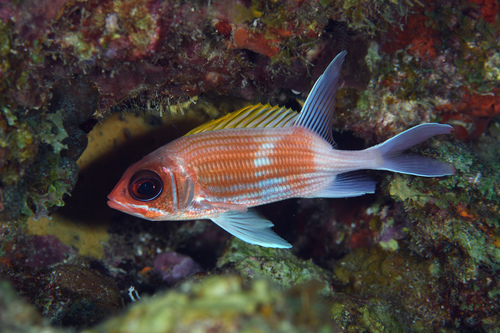
Squirrelfish
The Bluefin Tuna (Thunnus thynnus, Thunnus orientalis, and Thunnus maccoyii) are among the ocean's most impressive predators. These large, powerful fish are renowned for their incredible speed, long migrations, and high commercial value. They are a vital part of marine ecosystems and are culturally significant in many regions.
4 8 years
Lifespan
25 - 35 cm
Length
Least Concern
Conservation Status
5 km/h
Swimming speed
Carnivorous
Diet
Local Migration
Migration
Appearance Overview
The Bluefin Tuna is a large, torpedo-shaped fish with a metallic blue back and a silvery-white belly.
Coloration
Dark metallic blue on top, silvery-white underside
Body Shape
Torpedo-shaped, streamlined for speed
Fins
Two dorsal fins, the first depressible; small, yellow finlets running from the second dorsal and anal fins to the tail
Scales
Small and cycloid (smooth-edged)
Length
Up to 13 feet (4 meters), commonly 6.5 feet (2 meters)
Weight
Up to 2,000 lbs (907 kg), commonly 550 lbs (250 kg)
Diet
Carnivorous, feeding on a wide variety of fish (such as herring, mackerel, and hake), squid, eels, and crustaceans.
Feeding Behavior
Highly active predator, often hunting in coordinated groups. They use their speed and agility to ambush prey, and their warm-bloodedness allows them to hunt in colder waters.
Social Behavior
Forms large schools, sometimes segregated by size. They are highly migratory, traveling vast distances across oceans.
Commercial Relevance
Extremely high value, particularly in the sushi and sashimi markets. The meat, especially the fatty belly meat (toro), is considered a delicacy and commands premium prices.
Conservation measures
Subject to international fishing quotas and regulations managed by organizations like the ICCAT (International Commission for the Conservation of Atlantic Tunas). Marine Protected Areas and fishing gear restrictions are also in place in some regions.
Status
Varies by species: Atlantic Bluefin Tuna - Endangered; Pacific Bluefin Tuna - Vulnerable; Southern Bluefin Tuna - Critically Endangered.
Threats
Overfishing (primarily for the sushi market) is the major threat. Bycatch in fishing gear targeting other species, climate change (affecting prey distribution and spawning grounds), and habitat degradation also pose risks.
Habitat Distribution
Depth Range
0-1,000 meters (3,280 feet), but commonly found in the upper few hundred meters.
Geographic Range
Atlantic Bluefin Tuna: Western and Eastern Atlantic Ocean, Mediterranean Sea. Pacific Bluefin Tuna: North Pacific Ocean. Southern Bluefin Tuna: Southern Hemisphere oceans.
Preferred Environment
Temperate and subtropical waters; pelagic (open ocean) species, often associated with continental shelves and slopes.
Reproduction and Life Cycle
Breeding Habits
Spawns in specific areas, such as the Mediterranean Sea and the Gulf of Mexico for Atlantic Bluefin. Spawning is typically seasonal and tied to water temperature.
Development Stages
Eggs are pelagic (free-floating) and hatch into larvae. Larvae are planktonic and undergo rapid growth. Juveniles gradually develop the characteristics of adults.
Fecundity
Highly fecund; a single female can release millions of eggs (up to 30 million) during a spawning season.
Maturity Age
Varies by species and location; Atlantic Bluefin Tuna typically matures between 4-8 years, while Southern Bluefin may take longer (8-12 years).
Faqs about Squirrelfish
How fast can Bluefin tuna swim?
Bluefin tuna are among the fastest fish in the ocean, capable of bursts of speed up to 43 mph (70 km/h).
What is the lifespan of a Bluefin tuna?
Bluefin tuna can live for up to 40 years, although the average lifespan is around 15-25 years.
Are Bluefin tuna warm-blooded?
Yes, Bluefin tuna are warm-blooded, which is unusual for fish. They have a specialized circulatory system that allows them to maintain a body temperature higher than the surrounding water.
Do Bluefin tuna migrate?
Bluefin tuna undertake extensive migrations across oceans for feeding and spawning. Some populations travel thousands of miles.
Why is Bluefin tuna so expensive?
The high fat content, particularly in the belly meat (toro), gives it a rich, buttery flavor and texture that is highly prized in sushi and sashimi.
Is climate change affecting Bluefin tuna?
Yes, in addition to overfishing, climate change impacts the distribution of their prey and the suitability of their spawning grounds.
What organizations manage Bluefin tuna fishing?
ICCAT is the primary organization responsible, setting quotas and management measures for Atlantic Bluefin. Other regional fisheries management organizations (RFMOs) play a role in managing Pacific and Southern Bluefin stocks.
Can consumers help protect Bluefin tuna?
Consumer choices can make a difference. Look for sustainably sourced seafood options and avoid Bluefin tuna unless its origin and fishing method are clearly sustainable.
Copyright @ Nature Style Limited. All Rights Reserved.
 English
English